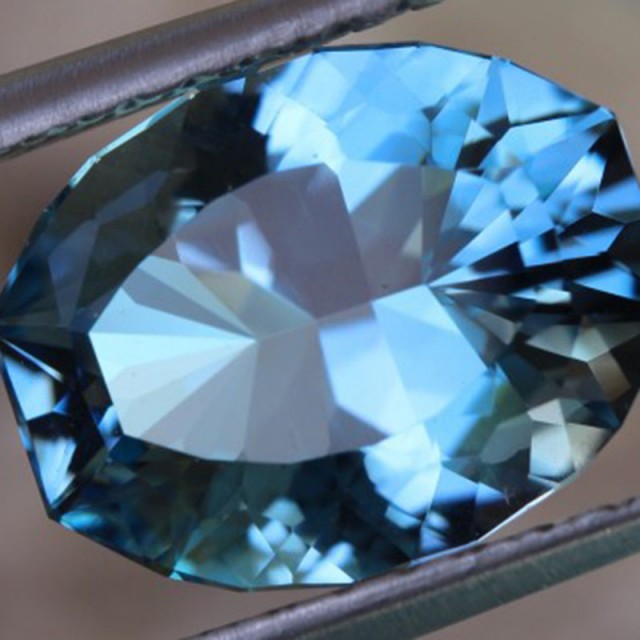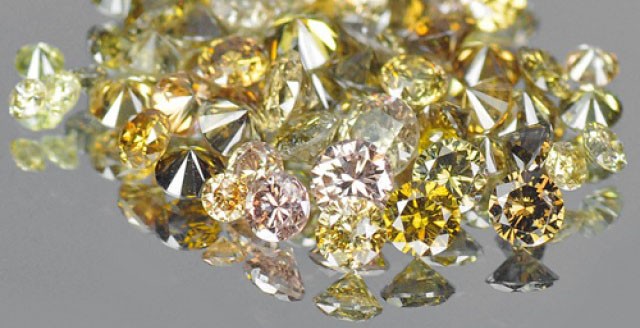
Pubblicato il 5th Mar 2019
Modificato il 4th Jun 2025
Le pietre preziose irradiate sono pericolose?
 Tra tutti i trattamenti per le pietre preziose attualmente disponibili sul mercato, ce n'è uno che solleva sempre interrogativi: l'irradiazione.
Tra tutti i trattamenti per le pietre preziose attualmente disponibili sul mercato, ce n'è uno che solleva sempre interrogativi: l'irradiazione.
Quando si sente la parola "irradiazione", la prima domanda che viene in mente è: è sicura? Buone notizie: sì, lo è. Esploreremo perché le pietre preziose vengono irradiate e cosa fa la NRC (Nuclear Regulatory Commission) per garantire la vostra sicurezza.
La pietra preziosa che ha suscitato più discussioni è il topazio blu. Dagli anni '80, questa pietra preziosa viene regolarmente sottoposta a irradiazione per conferirle il colore blu che tutti conosciamo e amiamo. Esistono due metodi per irradiare il topazio blu, ed entrambi prevedono l'utilizzo di reattori nucleari.
Il primo metodo consiste nell'utilizzare un flusso di elettroni per indurre il colore. Il secondo metodo consiste nell'utilizzare un flusso di neutroni.
Mentre il metodo elettronico produce un topazio che non rappresenta un pericolo per l'uomo, il topazio trattato con il metodo neutronico può continuare a emettere radiazioni per anni. Dopo approfondite ricerche condotte da vari enti, tra cui l'NRC, sono stati introdotti rigorosi controlli per garantire che tutto il topazio blu irradiato con neutroni immesso sul mercato sia sicuro da maneggiare.
Quali pietre preziose vengono comunemente irradiate?
L'elenco seguente fornisce esempi dei colori delle pietre preziose che possono essere ottenuti tramite irradiazione. Questo non è un elenco completo e sono disponibili altre varianti di colore.
Topazio : incolore prima del trattamento. Blu dopo il trattamento.
Diamante : incolore a verde/blu
Perle : colore chiaro al grigio-blu
Quarzo : incolore / giallo / verde pallido a marrone / ametista / fumé / rosa
Tormalina : incolore a giallo / marrone / rosa / rosso


Processi di irradiazione
Esistono tre metodi principali per irradiare le pietre preziose. Ogni metodo utilizza una struttura diversa e può avere effetti diversi sulle pietre preziose.
Bombardamento neutronico – Uso di un reattore nucleare
Bombardamento elettronico (beta) – Utilizzo di un acceleratore
Radiazioni gamma – Utilizzo di un impianto al cobalto-60 (questi impianti sono comunemente utilizzati per sterilizzare le apparecchiature mediche)
Il processo di irradiazione può essere paragonato a delle palline. Il metodo dei neutroni spara grosse palline da tennis contro il soggetto per indurre il colore. Il metodo degli elettroni usa palline minuscole per sparare sul soggetto. La radiazione gamma usa palline microscopiche con enormi quantità di energia per indurre il colore.

L'irradiazione rende la pietra preziosa radioattiva?
Più a lungo una pietra preziosa viene esposta all'irradiazione, maggiore è la probabilità che diventi radioattiva. Il motivo per cui le pietre preziose diventano radioattive è l'attivazione delle impurità al loro interno. Le pietre trattate con irradiazione elettronica o neutronica rimarranno radioattive per un certo periodo di tempo. Le pietre trattate con radiazioni gamma non diventeranno radioattive.
Per le pietre trattate con irradiazione elettronica, il livello di radiazione del materiale in uscita dal reattore è generalmente considerato sicuro da maneggiare dall'NRC. Tuttavia, esistono linee guida rigorose per garantire che il Topaz venga conservato per diversi mesi. È importante ricordare che le radiazioni decadono nel tempo, quindi se le pietre sono sicure da maneggiare appena uscite dal reattore, lo saranno anche una volta immesse sul mercato.
La radiazione neutronica richiede più tempo per diventare sicura. Secondo l'NRC, il tempo medio necessario affinché Topas appena irradiato con neutroni diventi sicuro è di 12-24 mesi.
A quante radiazioni sarò esposto?
Le radiazioni sono ovunque. Sono parte integrante della vita e non potremmo vivere senza. Facciamo qualche rapido confronto. Le radiazioni si misurano in millirem, ovvero la dose di assorbimento di radiazione.
Un topazio da 6 carati indossato per un anno (supponendo che il livello di radiazione sia al massimo ritenuto sicuro dalla NRC) = 0,03 millirem
Ora confrontiamo questo con altre cose comuni, tutte basate su un'esposizione di 1 anno.
Corona in porcellana o denti finti = 0,07 millirem (2,3 volte quello del topazio)
Radiografia del torace = 10 millirem (333 volte quella di Topaz)
Cibo e acqua (sì, anche questi hanno radiazioni naturali) = 30 millirem (1.000 volte quello di Topaz)
Volo transatlantico = 2,5 millirem (83 volte quello di Topaz)
Guardare la TV = 1 millirem (33 volte quello di Topaz)
In che modo l'irradiazione causa il colore?
Questo è un argomento molto complesso, quindi analizziamolo con alcuni esempi. Spiegheremo i due modi in cui le gemme ottengono il loro colore: cromofori (impurità) e centri di colore (difetti).
Cromofori
I cromofori sono impurità presenti nei minerali che causano il colore.
Prendiamo ad esempio lo zaffiro . Lo zaffiro puro è trasparente. Aggiungi titanio come impurità e diventa blu. Aggiungi ferro e diventa giallo. Aggiungi cromo e diventa rosa. Aggiungi ferro e cromo e ottieni arancione/rosa (padparadscha).
Questo è il modo più comune in cui le gemme ottengono il loro colore. Quindi, se si desidera esaltare uno zaffiro, è possibile diffondere il titanio (attraverso la diffusione superficiale) e ottenere una pietra più blu.

Centri di colore (difetti)
Ora, diamo un'occhiata ai diamanti. Tutti i diamanti sono carbonio puro. Quindi, come fanno ad avere diamanti rosa , diamanti gialli e diamanti rossi ? La risposta: un centro di colore. Questo è un difetto nella struttura cristallina della gemma, ed è questo difetto a causare il colore.

Se prendi kunzite , topazio, hiddenite o diamante e provi a provocare un difetto nel reticolo cristallino, otterrai un colore.
Come si crea un difetto? Si frantumano gli atomi all'interno del cristallo. È qui che entrano in gioco la radiazione elettronica e quella neutronica. Si frantuma letteralmente la gemma con le radiazioni per causare un difetto che induce la colorazione.
Il colore è permanente?
Questi difetti possono essere riparati applicando energia alla gemma. Nel caso della kunzite, questa energia si manifesta sotto forma di radiazione UV del sole. L'energia solare ripara la struttura cristallina e rimuove il colore rosa dalla gemma.
Troverete molta hiddenite sul mercato che è stata irradiata. Ha un centro di colore indotto, che causa il colore verde. Questo colore è sensibile alla luce solare, proprio come la kunzite.
Tuttavia, il colore del topazio e della tormalina, ad esempio, è stabile. Il processo per creare il colore blu del topazio prevede l'irradiazione della pietra preziosa e il suo successivo riscaldamento. Questo processo di riscaldamento stabilizza il colore, creando una gemma che non sbiadirà né si deteriorerà nel tempo.
Parte del topazio marrone che vedrete è il risultato della radiazione elettronica. Se questo topazio viene riscaldato, diventerà blu e il colore si stabilizzerà. Tuttavia, qualche anno fa qualcuno decise di irradiare il topazio. Ma, quando divenne marrone con una sfumatura arancione, decise di non riscaldarlo per renderlo blu, ma di venderlo come topazio imperiale. Siti come Gem Rock Auctions non consentono la vendita di queste pietre come topazio imperiale.
Ora che sai quanto sono sicure le pietre preziose irradiate, è il momento di decidere se vuoi davvero indossare quella dentiera. Dopotutto, preferiresti una dentiera finta o il doppio delle pietre preziose di topazio?
Acquista pietre preziose
Cerca il Gemstone Encyclopedia
Aste correlate
articoli Correlati
Le perle di Tahiti sono delle bellissime perle dal colore più scuro, disponibili in tantissime forme, dimensioni e colori diversi. Scopri di più su questa pietra preziosa e dai un'occhiata alle splendide perle che abbiamo in vendita.
9th May 2018
La kunzite è una gemma di spodumene dal rosa chiaro o lilla al viola intenso. È rinomata per la sua eccellente purezza, la sua colorazione e il prezzo accessibile. Scopri il significato, il valore e gli usi della kunzite!
9th May 2018
Le antiche civiltà della Mesoamerica svilupparono calendari scritti molto accurati e, tra questi, il calendario Maya è il più sofisticato.
18th Oct 2018
Articoli Recenti
Scopri la storia, le proprietà, il valore e i consigli per la cura della pietra sangue di pollo, una pietra preziosa rara e vibrante, apprezzata per i suoi straordinari motivi rossi e il suo significato culturale.
8th Dec 2025
La gaylussite è un minerale raro, utilizzato principalmente a livello industriale, poiché si intorbidisce facilmente a causa della disidratazione. Scopri la storia, le proprietà, gli usi e le caratteristiche della gaylussite in questa guida completa.
7th Dec 2025
La chiolite è un minerale raro, da incolore a bianco, imparentato con la criolite. Le gemme sono molto rare e provengono solo da un paio di fonti. Scopri qui gli usi, la storia, i prezzi e le caratteristiche della chiolite.
5th Dec 2025
Categorie di articoli
How To's is where you will find helpful articles from gem Rock Auctions on how to cut gemstones, select gemstones and buy gemstones.
9 Articoli








